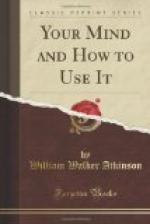Against cramming it may further be urged that the hasty impression of a mass of new material is not likely to be lasting; particularly is this true when the cramming is made specifically for a certain examination. As we saw in the chapter on memory, the intention to remember affects the firmness of retention, and if the cramming is done merely with reference to the examination, the facts learned may be forgotten and never be available for future use. So we may lay it down as a rule that feverish exertions at the end of a course cannot replace conscientious work throughout the course. In spite of these objections, however, we must admit that cramming has some value, if it does not take the form of new acquisition of facts, but consists more of a manipulation of facts already learned. As a method of review, it has an eminently proper place and may well be regarded as indispensable. Some students, it is true, assert that they derive little benefit from a pre-examination review, but one is inclined to question their methods. We have already found that learning is characteristically aided by reviews, and that recall is facilitated by recency of impression. Reviewing just before examination serves the memory by providing repetition and recency, which, as we learned in the chapter on memory, are conditions for favorable impression.
A further value of cramming is that by means of such a summarizing review one is able to see facts in a greater number of relations than before. It too often happens that when facts are taken up in a course they come in a more or less detached form, but at the conclusion of the course a review will show the facts in perspective and will disclose many new relations between them.
Another advantage of cramming is that at such a time, one usually works at a high plane of efficiency; the task of reviewing in a few hours the work of an entire course is so huge that the attention is closely concentrated, impressions are made vividly, and the entire mentality is tuned up so that facts are well impressed, coordinated and retained. These advantages are not all present in the more leisurely learning of a course, so we see that cramming may be regarded as a useful device in learning.
We must not forget that many of the advantages secured by cramming are dependent upon the methods pursued. There are good methods and poor methods of cramming. One of the most reprehensible of the latter is to get into a flurry and scramble madly through a mass of facts without regard to their relation to each other. This method is characterized by breathless haste and an anxious fear lest something be missed or forgotten. Perhaps its most serious evil is its formlessness and lack of plan. In other words the facts should not be seized upon singly but should be regarded in the light of their different relations with each other. Suppose, for example, you are reviewing for an examination in mediaeval history.




